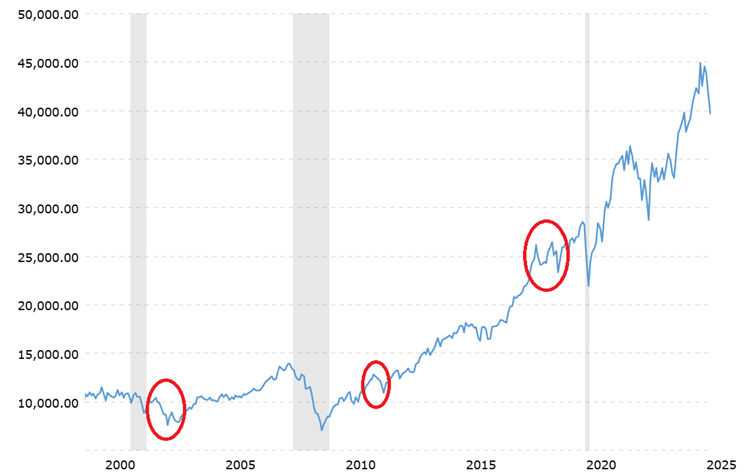The last couple of months have been characterized by turbulent economic policies and uncertainty. It is unclear, at the moment, what long-term impact the current executive’s decisions will have on the economy and on small businesses.
As a small business owner, the dominating headlines regarding the tariffs, the stock market, and the rumors of recession can be overwhelming. The tariff policy is inconsistent and volatile and stock market is unpredictable.
There are limits on how small businesses can anticipate changes and mitigate risk exposure. It is important, therefore, to focus on the relatively foreseeable changes the Federal Reserve might make.
- The stock market is more reactive to all kinds of factors than the wider economy and fluctuations are part of the norm.
- Small business owners are generally not active on the stock market and stock price fluctuations generally do not impact small businesses.
- Contrarily, consumer confidence is the largest influence of small business performance.
- Among the factors that influence consumer confidence are interest rates. Interest rate hikes shake consumer confidence more than tariffs and stock market fluctuations.
- The Federal Reserve is likely to increase interest rates in the wake of tariff-induced inflation and adversely affect small businesses.
Raise, Cut or Hold Interest Rates? How Federal Reserve Action Affects Your Startup.
A Brief Note about Tariffs and Recessions
Several sources have broken down the impact of tariffs on small businesses in detail. The key takeaways included the fact that small businesses are hurt by tariffs, whether they rely on imports for operations or export their products and services. Domestic tariffs on imports increase the cost of production in the US. Facing higher production costs, importing businesses will have no choice but to pass those costs to customers (domestic inflation) or go out of business. On the other hand, foreign tariffs on exports will raise the price of US-produced goods abroad (foreign inflation). This reduces the demand for US produced goods and services in foreign markets. A trade war would hurt both domestic and foreign businesses and consumers.
Another key takeaway is the potential of a recession. Tariff-induced inflationary pressure felt by small businesses that leads to significantly reduced demand may result in job losses and a recession. When consumers face higher prices, they tend to buy less. With fewer customers, businesses tend to scale down operations or close altogether. As the employer of the largest share of private workers, if too many small businesses slow down or shut down, many jobs will be lost. If enough jobs are lost and unemployment rises, the economy will contract, and the US may face a recession.
Tariffs and Recession: Keeping Your Emerging Business Afloat
And That Explains the Stock Market
Traders on the stock market try to anticipate changes in the economy. If the economy is doing well, companies on the stock exchange generally have plenty of customers and are likely to make profits. If prices rise and jobs are lost, fewer people are likely to buy products and services as much as they would have in better conditions. With lower sales and profits, the price of stocks is likely to drop. This is why the stock market plummeted when tariffs were announced and rebounded when on the news of a 90-day pause on tariffs. Traders expect businesses to perform better in the absence of tariffs and worse under the threat of a recession.
However, most small business owners are not active traders on the stock exchange, even if their retirement savings may depend on them. The intuition that fluctuations on the stock market should not have a lasting effect on their small business is largely accurate. Traders, in general, react to all kinds of factors, some unrelated to the wider market. For example, the recent developments in the AI space significantly impact mostly the largest tech companies and that volatility is reflected in all kinds of portfolios. The point being that volatility is the norm and small business owners need not stress about factors no one can control; factors that barely impact their business. Except when they do.
It’s Almost Always About Consumer Confidence
Ancient wisdom generally says the line goes up. There are dips here and there, but an upward trend is the norm for the average American who glances at their retirement investments every now and then. As such, sustained gains in the stock market are barely noticed. On the contrary, sustained dips raise eyebrows. Below is a chart of the historical values of the Dow Jones Index with recession years shaded in grey.

Stock Market Volatility v. Recession Years. Source: Macrotrends as of April 24, 2025
Some consider a significant drop in the stock market to be a signal of a pending recession. An IMF publication referred to asset prices as a “harbinger of recession”. Indeed, prior to every recession in the last 30 years, the stock market dipped and continued to drop well into the recession until some turning point. However, this is not always the case. Circled in red, April 2002 to March 2003, June to September 2011 and the first and final quarters of 2018, are periods of sustained stock market drops that did not lead to a recession. As recently as August, 2024, Forbes considered if the then ongoing stock market dive was an indicator of an impending recession.
The answer is yes and no. But, more often than not, a dip in the stock market is just that. A dip, sustained or not. The stock market is less a harbinger of a recession and more of a reflection of investor and, sometimes, consumer confidence. Investors are much more sensitive and reactive to current affairs – which is why the market is volatile. On the contrary, consumers are slower to respond and only react to big news. Of the four recessions in the last 30 years, the great recession of 2008 eroded consumer confidence the most, likely because of the catastrophic news in the financial markets. On the contrary, the COVID-induced recession was immediately countered by government putting money directly in consumers’ pockets and giving them the confidence to spend.


We earn a commission if you make a purchase, at no additional cost to you.
Why Watch the Federal Reserve?
Because if there is one economic metric capable of shaking consumer confidence to the core on a personal level, it is not the tariff levels, the stock market index, or even a sustained contraction in GDP (recession). It is the interest rates. Home loans, car payments, credit card debt, overdrafts, and personal, business, or student loans are among the most significant expenses in individual and family budgets. Any increase in interest rates means consumers and, specifically, small business customers will have less disposable income. That, when coupled with a downward trending stock market reducing the value of their retirement savings, means customers are more likely to save than spend.
Among the primary goals of the US Federal Reserve are to promote “maximum employment, stable prices, and moderate long-term interest rates”. The term “maximum employment” has been a subject of debate, but most economists would agree it is nowhere near 100% employment. Similarly, “moderate” when it comes to interest rates depends on the context of the economy. However, what is not up for debate is the goal of “stable prices”. Typically, the Federal Reserve tries to maintain an inflation rate around 2%. If, for example, the base tariff policy of 10% persists, the price inflation of any imported goods will be at a minimum of 10% and it is highly likely that the general rate of inflation will exceed 2%.
When inflation skyrockets, it is often the small businesses and consumers that bear the brunt. “The Federal Reserve seeks to control inflation by influencing interest rates. When inflation is too high, the Federal Reserve typically raises interest rates to slow the economy and bring inflation down” (The Cleveland Fed). A combination of low consumer confidence, high inflation, and escalating interest rates has been the death of many a small business. The loss of customers, the higher cost of business funding, the potential rental hikes, and the increase in the cost of imports often means small business owners struggle to stay above water.
How to Manage Business During Inflation and Keep Customer Trust
What Can Small Businesses Do?
The good news is that no interest rate hikes have been announced, as of early May. Unfortunately, it is unclear if and how a trade war will escalate. Regardless, for those looking to protect their small business from this economic turmoil, there are some steps to mitigate the impact of tariffs, a recession, and interest rate hikes.
- Use cash reserves sparingly – In the case of interest rate hikes, getting business credit is difficult, particularly for small businesses. Cash flow problems are among the leading causes of business failure.
- Consider an alternative supply chain – Tariffs are often targeted at specific countries or regions. If you can source imports from a low-tariff region, explore your options.
- Invest in marketing – Retaliatory tariffs in foreign markets will make your products less competitive. If you primarily export your products or services, consider extending them to other countries. If you are exclusively distributing domestically, consider expanding your reach by investing in marketing.
- Reduce labor costs – Many roles in small businesses need not be conducted on site and in person. Marketing, accounting, and IT services are some roles that can be outsourced offshore at an affordable rate.
- Consolidate high interest debt – A higher interest rate expense will eat into your cash flow.
Image by freepik
Startup Financing: From Traditional Loans to Innovative Solutions
#Small #Businesses #Watch #Federal #Reserve #Stock #Market